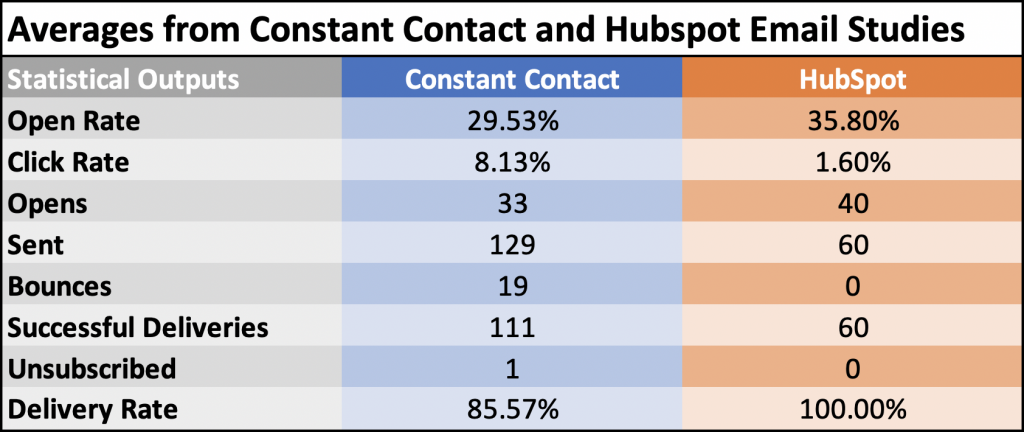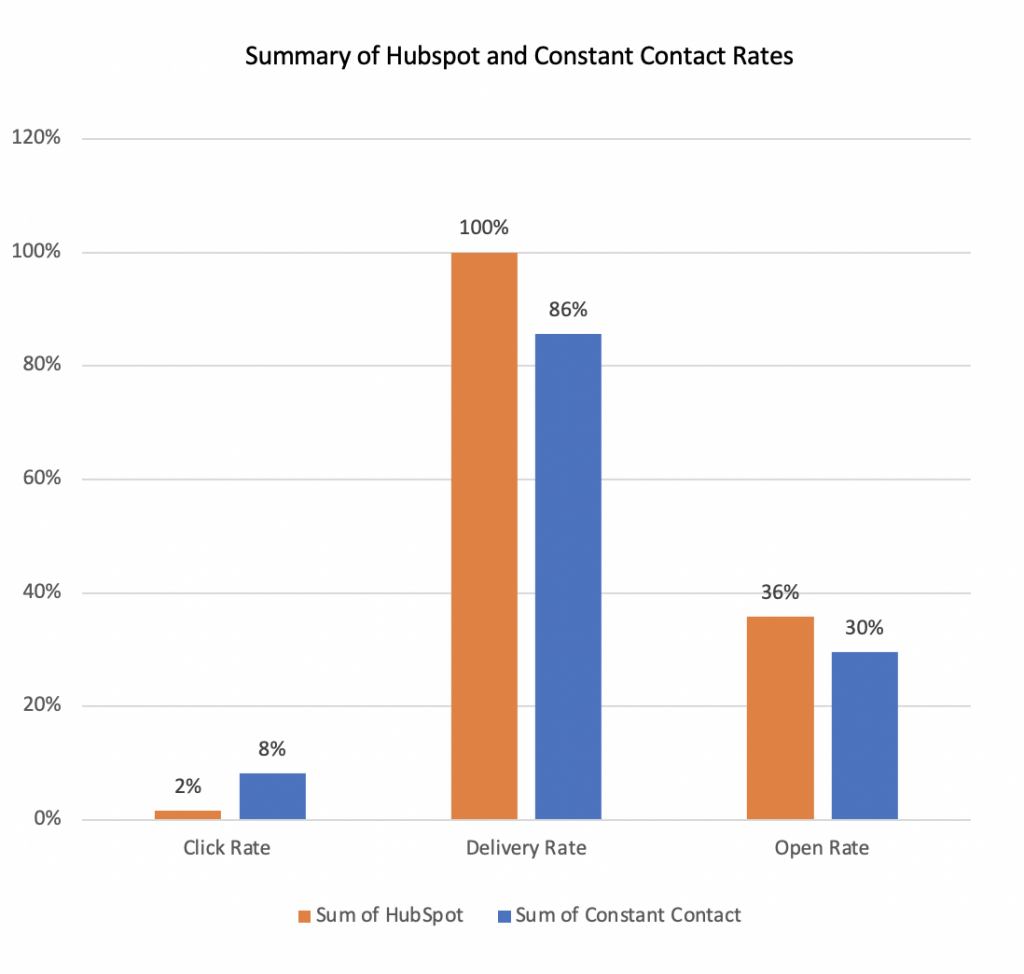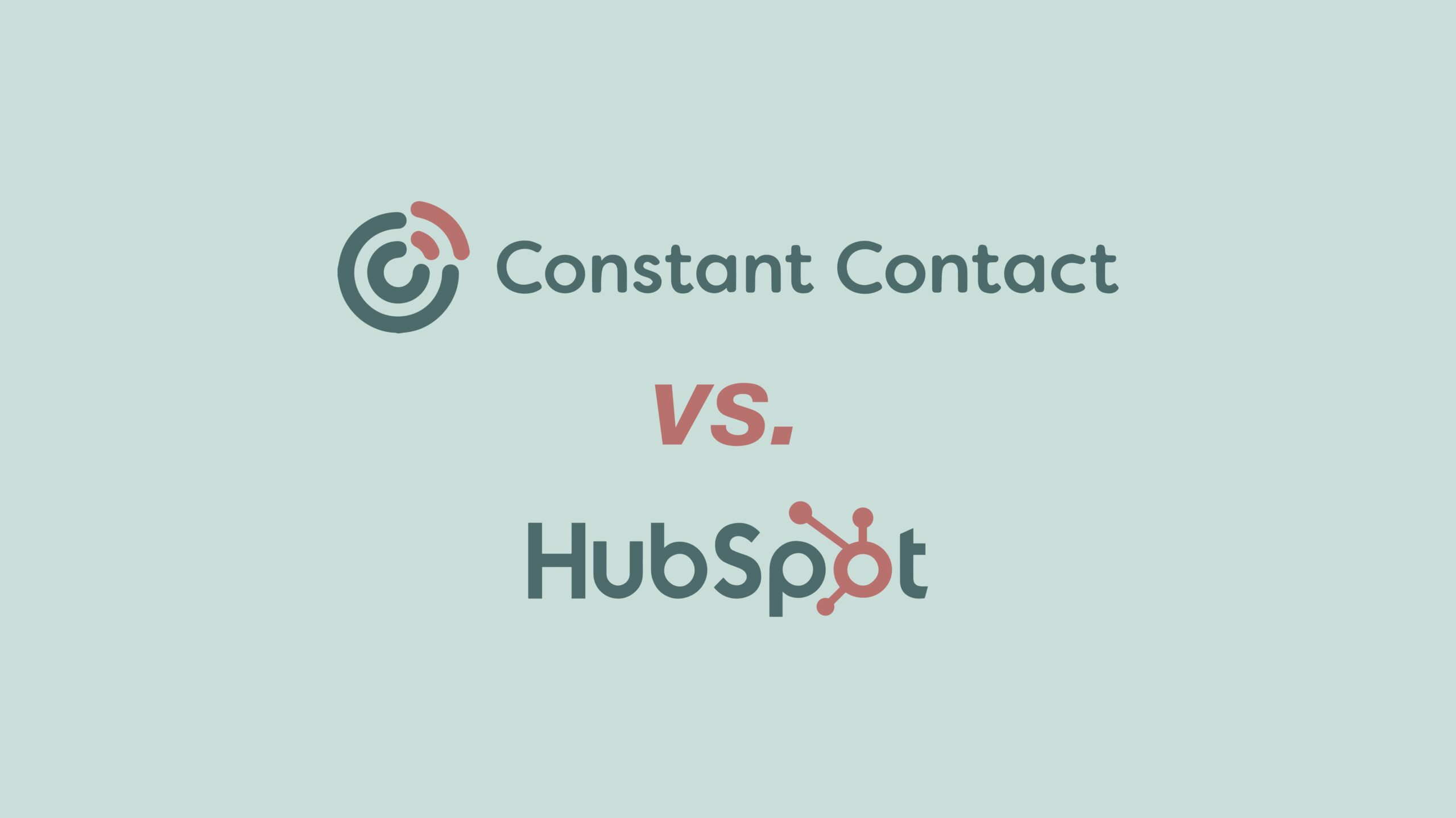Several months ago, we carried out a study by examining the email deliverability of two very popular email services; HubSpot and Constant Contact. You can read that blog here where we broke down the data we found and what pros and cons each program offers. Fast forward a few months and we are now presenting you with updated data from our study where we sent numerous emails using both services and can now provide even more accurate data.
Here is the chart listing our findings:

Let’s break down some of this data. Right off the bat we can see HubSpot clearly has a higher open rate of 35.8% in comparison to Constant Contact’s 29%. Both percentages are lower than what we found in our first experiment, however HubSpot seems to consistently have a higher Open Rate. This is important because it means more of our subscribers are seeing our emails via HubSpot.
Weirdly enough, while Constant Contact’s open rate is lower than HubSpot’s, Constant Contact’s click rate is almost 7% higher than HubSpot’s. This means that while people are opening emails from Constant Contact less, those that do are more likely to click the imbedded links within the email.
Another interesting piece of data to take note of is that because we use HubSpot typically for our emails, HubSpot’s email list is much more refined. This led to emails sent via Constant Contact to occasionally bounce. This is evident by also observing HubSpot’s 100% delivery rate in comparison to Constant Contact’s 86%. It’s not that Hubpot is better at delivering them, it’s just that Hubspot’s algorithms identify which emails are likely to bounce or have bounced, and suppress them for future sends. You can create suppression lists for bounced contacts in either software, but Hubspot does this for you automatically.
This is both a benefit and a drawback since Hubspot also looks to see if someone engaged with it, and if they did not, they send them to “unengaged contacts”. How do they know the contact is unengaged? They simply note the email wasn’t opened over time. That’s not really unengaged – what if the customer didn’t see it in their Promotions tab for two or three send cycles? They may be your BEST client of all, but Hubspot says they’re unengaged.
To get around this, periodically pull the unengaged clients out of that list and send them a personal email. “Hey, Mary, we noted you haven’t seen the last few emails we sent. Did they go to spam? Or your promotions box? If you want, check out our articles here and here, and click here to stay in touch!” The latter link goes to a ‘reengagement’ form that reconfirms they want your email. You can use THAT list to add back to your contacts and remove them from unengaged.
At the end of the day, despite Constant Contact’s higher click rate, Hubspot’s email system has a higher deliverability. Attached below is a chart displaying the rates for both HubSpot and Constant Contact.

After months of testing, the battle of the best email deliverability has come to a close and further reinforced our original findings from months ago. While Constant Contact has a high click rate and a decent open rate, HubSpot’s refined contact list shine through once again leading to a higher open rate.
Another interesting test is whether the email gets into the priority inbox. It’s not obvious from any of this data, but Hubspot’s emails landed in our tester’s priority inboxes far more than Constant Contact’s did. If your clients are managing their email with priority, promotion, social and updates, and your email consistently lands in priority versus promotions, you have a better change of it being opened.
During our testing, we optimized DMARC – DKIM and SPF records for both of these services. That didn’t result in more email being opened or clicked, but it sure affected the priority inbox numbers (Hubspot). You can read more about how to manage the DMARC settings for your business at this blog post here.Don’t know what any of that means? Check out the blog, we explain it all In plain English.
Through all of this, we didn’t talk about a key difference between these platforms. While Constant Contact and Hubspot both allow sending mass email, only Hubspot has a fully fledged CRM built in.
So if you just need to email your clients (in the case of e-commerce craft, sewing and knitting retailers, for instance), Constant Contact’s rich design interface and ease of use may be perfect. If you need more one-to-one contact such as business services, coaching or training, you’ll actually find more benefit to the Hubspot CRM bundled with the email marketing tools. There is no one perfect fit; you’re looking to match your business model with the best solution.
For a commerce retailer who has a lot of people who signed up to receive a one time offer, a suppressed ‘unengaged’ list may not be ideal, and a click through rate that’s higher certainly would be. Constant Contact would be a better choice. Same, too, if you’re interested in a better design interface.
If you’re a life or health coach, you would be better served by a system that allows you to manage individual clients in a CRM, note the engagement you’ve had with them and custom tailor and track your responses to them. Hubspot would be a better choice for this. Email marketing is an essential tool for your business’s success. Getting emails into inboxes is important, while getting your clients to open them is even more vital. In summary, if you compare them head to head, we can now confirm that HubSpot is the better email system to use in order to ensure your deliverability to the primary inbox – and to the customer in general.
Need help deciding on an email service? Do you need 1:1 help diving into your server or host’s email records to set up DMARC? We can coach you through these things in helpful, friendly training sessions designed to get you going. In as little as 30 minutes, we can help you decide on a service based on your business type, or we can help with DMARC, or we can show you how to import your customer list, or we can show you how to connect your commerce + your email services. Let us know what you need, below!






